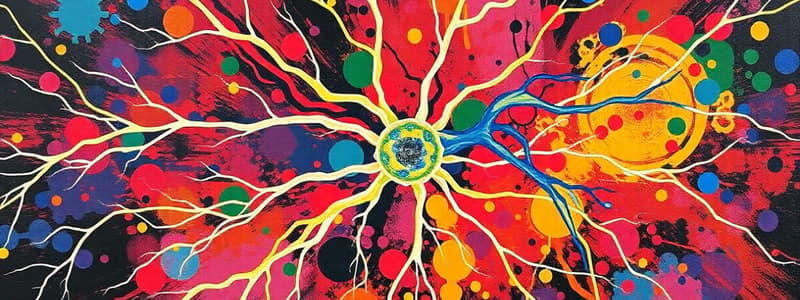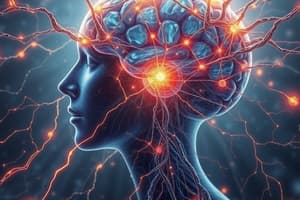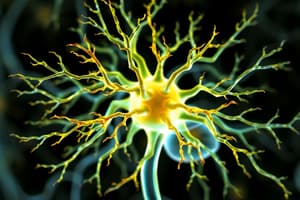Podcast
Questions and Answers
What is one characteristic of nerve impulse transmission compared to hormone transmission?
What is one characteristic of nerve impulse transmission compared to hormone transmission?
- It is more widespread.
- It targets specific parts of the body. (correct)
- Transmission is usually slower.
- Effects are long lasting.
What happens when the generator potential in a sensory neurone reaches the threshold level?
What happens when the generator potential in a sensory neurone reaches the threshold level?
- An all-or-nothing action potential is triggered. (correct)
- An increased frequency of action potentials is generated.
- The sensory neurone becomes adapted to the stimulus.
- The chemical transmitter is released into the synapse.
Why is the ability to respond to stimuli important for an organism's survival?
Why is the ability to respond to stimuli important for an organism's survival?
- It increases the chances of survival against environmental extremes. (correct)
- It ensures the development of complex nervous systems.
- It allows for better communication with other organisms.
- It guarantees a permanent and irreversible effect.
Which of the following is NOT a feature of the endocrine system?
Which of the following is NOT a feature of the endocrine system?
What is the primary function of adaptation in sensory neurones?
What is the primary function of adaptation in sensory neurones?
In relation to response duration, how do the nervous and endocrine systems differ?
In relation to response duration, how do the nervous and endocrine systems differ?
How do rods differ from cones in terms of visual acuity?
How do rods differ from cones in terms of visual acuity?
What role do receptors play in the nervous system?
What role do receptors play in the nervous system?
Which component of rod cells is crucial for the process of light transduction?
Which component of rod cells is crucial for the process of light transduction?
What type of response does a sensory neurone exhibit if the generator potential is below the threshold level?
What type of response does a sensory neurone exhibit if the generator potential is below the threshold level?
What is the primary function of the myelin sheath surrounding axons?
What is the primary function of the myelin sheath surrounding axons?
Which part of the neurone carries nerve impulses towards the cell body?
Which part of the neurone carries nerve impulses towards the cell body?
What distinguishes myelinated neurones from unmyelinated neurones?
What distinguishes myelinated neurones from unmyelinated neurones?
Which type of neurone is responsible for transmitting impulses from a receptor to a relay neurone?
Which type of neurone is responsible for transmitting impulses from a receptor to a relay neurone?
What is the role of Schwann cells?
What is the role of Schwann cells?
Which characteristic is true of motor neurones?
Which characteristic is true of motor neurones?
What are the gaps between the myelin sheaths called?
What are the gaps between the myelin sheaths called?
What role do chemoreceptor cells in taste buds primarily serve?
What role do chemoreceptor cells in taste buds primarily serve?
Which type of stimulus are chemoreceptor cells specifically sensitive to?
Which type of stimulus are chemoreceptor cells specifically sensitive to?
What is the functional significance of the microvilli in chemoreceptor cells?
What is the functional significance of the microvilli in chemoreceptor cells?
How do chemoreceptor cells initiate a nerve impulse?
How do chemoreceptor cells initiate a nerve impulse?
Which of the following statements is true regarding the specificity of chemoreceptor cells?
Which of the following statements is true regarding the specificity of chemoreceptor cells?
What is the primary result of the receptor potential generated by chemoreceptor cells?
What is the primary result of the receptor potential generated by chemoreceptor cells?
How many types of basic tastes are recognized by chemoreceptor cells?
How many types of basic tastes are recognized by chemoreceptor cells?
Which part of the taste bud allows chemicals from saliva to contact chemoreceptor cells?
Which part of the taste bud allows chemicals from saliva to contact chemoreceptor cells?
What function does the central nervous system perform in relation to sensory receptor feedback?
What function does the central nervous system perform in relation to sensory receptor feedback?
What occurs after a chemical binds to a chemoreceptor cell's specific membrane receptor?
What occurs after a chemical binds to a chemoreceptor cell's specific membrane receptor?
Flashcards
Stimulus and response
Stimulus and response
The ability of living organisms to react to changes in their environment.
Receptors
Receptors
Specialized cells that detect changes in the environment.
Effectors
Effectors
Organs or parts of an organism that carry out a response to a stimulus.
Endocrine system
Endocrine system
Signup and view all the flashcards
Nervous system
Nervous system
Signup and view all the flashcards
Neurones
Neurones
Signup and view all the flashcards
Cell body
Cell body
Signup and view all the flashcards
Dendrites
Dendrites
Signup and view all the flashcards
Axon
Axon
Signup and view all the flashcards
Schwann cells
Schwann cells
Signup and view all the flashcards
Sensory neurones
Sensory neurones
Signup and view all the flashcards
Relay neurons
Relay neurons
Signup and view all the flashcards
Stimulus strength and generator potential
Stimulus strength and generator potential
Signup and view all the flashcards
Threshold for action potential
Threshold for action potential
Signup and view all the flashcards
Adaptation of receptors
Adaptation of receptors
Signup and view all the flashcards
Rods and Cones
Rods and Cones
Signup and view all the flashcards
Transduction in rod cells
Transduction in rod cells
Signup and view all the flashcards
Sensory receptors
Sensory receptors
Signup and view all the flashcards
Sense organs
Sense organs
Signup and view all the flashcards
Sensory transduction
Sensory transduction
Signup and view all the flashcards
Chemoreceptors
Chemoreceptors
Signup and view all the flashcards
Microvilli
Microvilli
Signup and view all the flashcards
Taste pore
Taste pore
Signup and view all the flashcards
Receptor potential
Receptor potential
Signup and view all the flashcards
Sensory transduction in chemoreceptors
Sensory transduction in chemoreceptors
Signup and view all the flashcards
Basic tastes
Basic tastes
Signup and view all the flashcards
Chemical transmission in taste buds
Chemical transmission in taste buds
Signup and view all the flashcards
Study Notes
Nervous Communication and Neurons
- The nervous system coordinates homeostatic mechanisms, responding to internal and external environmental changes.
- The nervous system and endocrine system are compared as communication systems.
- Neurons are specialized cells that rapidly transmit electrochemical signals (nerve impulses).
- A neuron has a cell body, dendrites (receiving end), and an axon (transmitting end).
- Sensory neurons transmit impulses from receptors to the central nervous system.
- Motor neurons transmit impulses from the central nervous system to effectors (muscles or glands).
- Relay neurons (interneurons) transmit impulses between other neurons.
- Myelinated neurons conduct impulses faster than unmyelinated neurons.
- Myelin sheaths are formed by Schwann cells wrapped around axons.
- Nodes of Ranvier are gaps in the myelin sheath.
- The central nervous system consists of the brain and spinal cord.
Stimulus and Response
- Organisms respond to internal or external stimuli.
- Responses increase the chances of survival.
- Receptors detect stimuli.
- Effectors carry out responses.
Comparison of Nervous and Endocrine Systems
- Endocrine system uses hormones transmitted through the blood, transmission is slow, effects are widespread, and responses are slow but long-lasting often permanent
- Nervous system uses nerve impulses transmitted through nerve fibers, transmission is rapid, effects are localized (specific), and responses are rapid but short-lived, and temporary.
Structure of Neurons
- Neurones have a cell body containing a nucleus; mitochondria, and rough endoplasmic reticulum (Nissl's granules).
- Dendrons (branching extensions) conduct impulses towards the cell body.
- The axon transmits impulses away from the cell body.
- Axons can be myelinated or unmyelinated with myelin providing insulation and speeding signal transmission.
Sensory Receptors
- Sensory receptors detect stimuli and are often located in sensory organs.
- Chemoreceptors in taste buds detect dissolved chemicals.
- Taste buds are located on the tongue's epithelium.
- Each bud has 50-100 chemoreceptors with microvilli for maximal surface area.
- Chemoreceptors convert stimulus energy into a receptor potential.
- Receptor potentials lead to generator potentials in sensory neurons and can trigger action potentials.
- Adaptation in receptors is a slow decline in response to a continuous stimulus.
- Sensory receptors are specific to stimuli and act as transducers converting stimulus energy into receptor potential.
Rods and Cones as Light Receptors
- Rods and cones are photoreceptor cells in the retina.
- Rods are more numerous than cones and are sensitive to light but not color.
- Cones are less sensitive to light but distinguish different colors.
- Transduction in light receptor cells occurs via rhodopsin (rods) or iodopsin (cones), which change form when exposed to light.
- The change in shape leads to a chain of reactions that change the permeability of the membrane of the receptor cell, creating a generator potential if the threshold is exceeded.
Studying That Suits You
Use AI to generate personalized quizzes and flashcards to suit your learning preferences.




